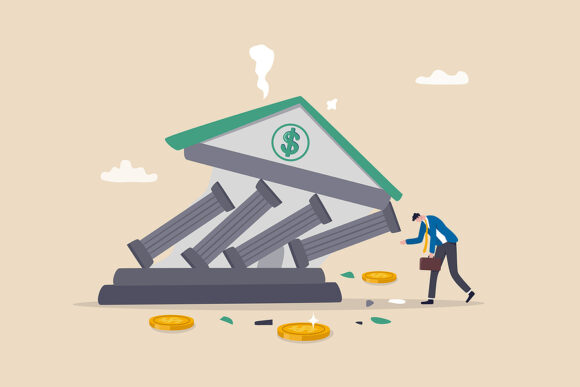On March 10, while most Americans were diligently toiling away in their jobs, very few people likely understood the silently ticking time-bomb sitting inside the balance sheets of many of our bank-brethren in our important banking industry. Few would have thought that over the second weekend in March, that the 11th largest banking company in the United States, with a 40-year history, roughly $215 billion in assets, a Loans to Deposits ratio of 43%, Tangible Common Equity of $11.8 billion and Tier -1 Regulatory Capital of 15.29%, an impressive CAGR (Compound Annual Growth Rate) of 39% and better than peer’s earnings metrics for the past 10 years, would implode in 36 hours.
That’s what happened with Silicon Valley Bank (SVB) and is the pressure that several other banks were facing due to notional losses in their bond portfolio, high concentration of uninsured deposits and the corresponding run on their bank deposits.
The Scandinavians have an apropos saying that, “Don’t Wave Hello from Across the Bridge.”
What went wrong at SVB and the other banks that recently failed? It was a confluence of circumstances that dominoed, but in short, the electronification of banking led to their unexpectedly rapid demise.
Deposits are the life blood of a bank. Deposit-withdrawal has become so efficient, that in an instant, crucially important bank deposits can be transferred out of a bank. When many depositors, who control a large amount and large percentage of the deposits withdraw, it can cripple the bank. It was a classic “run-on deposits,” through electronic withdrawals, that brought SVB to its knees in 24 hours.

SVB financial ratios (metrics that indicate financial stability) were impressive. SVB’s loan to deposit ratio was 43%, very low compared to its peers. A low loan to deposit ratio, as the term implies, means that the bank has fewer aggregate borrowers as a percentage of its cash and marketable securities. In bank parlance, the bank had balance sheet “liquidity”. SVB’s liquidity would have been the envy of its peers. Having the additional cash liquidity gave the bank options. It gave them financial flexibility; thus, putting SVB on the offense to invest that liquidity in loans or other financial and investment opportunities. Prima facia, this was good. SVB’s regulators likely would have considered them “safe and sound” and a low risk financial institution in Q4 of ’21 and Q1, Q2, Q3 and even Q4 of 2022.
So, what happened?
SVB’s liquidity and balance sheet strength was indirectly the source of their trouble and ultimate failure. The bank used its liquidity to buy or invest in high-quality Mortgage-Backed Securities and Government Bonds, (“US Treasuries”) backed by the United States Government. These types of investments are conservative and safe, correct? Yes, they are, normally! Unfortunately, the bank bought bonds with long(ish) dated maturities. For the past fourteen years since the Great Financial Crisis, the United States’ central bank, called the Federal Reserve Bank, has guided the economy with low interest rates. What economists call “loose monetary policy”. In addition to low interest rates, the FED juiced monetary policy through Quantitative Easing (QE), which was a novel policy action whereby the FED purchased a predetermined amount of government bonds and other financial assets to stimulate the economy. The resultant effect was really low interest rates (short-, mid- and long-term rates). This was like rocket fuel for the economy.
When Silicon Valley invested the bank’s liquidity in long(ish) maturing Government Bonds and Mortgage-Backed Securities it was in effect reaching for more yield, to wring out as much economic utility as it could from its large cash balances. These bank investments were extremely safe and conservative securities. Safe because the obligor on the bonds was the United States Government (for their US Treasuries). If these securities were held to their maturity date the bank would have received the full face-value of the bond. After all, what is the likelihood of the United States Government defaulting on its loans?
[Note: The United States Government is about 248 years old and the last time it defaulted on it a government bond was NEVER. It is certainly reasonable to assume that the US Government Bond will continue to pay its bond obligations given the statistical data of over two centuries of no defaults.]
In February 2022, the FED changed its monetary policy stance (to cool an overheated economy) and began raising the federal funds target interest rates for the financial system. The problem for SVB, and many other banks, was they invested in low yielding, long dated bonds; with interest rate on the rise, the low yielding bonds dropped in value as new bonds with the same duration were offered with higher coupons. SVB had billions of dollars of the bonds that dropped in value. As interest rates went higher throughout 2022, SVB’s low yielding bonds continued to drop further in value.
If one were not tuned into the economy and specifically bank balance sheets and more particularly the effects that rising interest rates have on US Treasury bonds and Mortgage-Backed Securities, there would have been no way to anticipate the wave. Heck, even if you were studying bank balance sheets the bank’s Tier 1 Capital remained unchanged.
So how would an investment in conservative government bonds trigger the demise of SVB? This is where it gets a little complicated.
Bonds pay an imputed interest rate (“coupon”) based on purchasing the bond at a discounted. For example, a $100 face or terminal value of a one-year bond bought at inception at $98 will pay roughly a 2% yield (2/100s). While the concept is a little wonky to think about, it becomes understandable when put in more familiar terms like when your local grocery store discounts tomatoes. Tomatoes normally priced at $5.00 a bushel, but on sale (or discounted) for $4.50 this week, indicates you’re buying $5.00 worth of tomatoes at $4.50. That’s an intrinsic benefit, or discount, of $.50. That same intrinsic benefit, or discount, is realized by a bondholder when the full face-value of the bond is paid to the investor in cash at maturity.
What seemed like a safe, conservative investment in government bonds by a bank with a ton of excess cash, became the silver bullet that triggered their ultimate demise.
To understand more specifically what happened with SVB’s bond portfolio, and the corresponding domino effect that killed the bank one has to understand another counter intuitive fact about bonds. “A bond’s yield moves inversely to its price.” Meaning when a bond goes up in price, its yield goes down, and when a bond goes down in price, its yield goes up. By way of example, remember the 2% bond described above ($100 of face, buyable at $98, leaving 2% in yield) … what if that same $100 in terminal-value bond, could be purchased at $96 because the price of the bond decreased (but the bond’s yield goes up). The bond’s yield would go up to 4% ($100 face, bought at $96 = 4% yield)? What’s a better yield, 4% or 2%? 4%, right? Herein lies the problem at SVB. With all their extra cash they purchased those long duration bonds with low coupons. As we said above, when the Federal Reserve Bank raise interest rates, the value of the SVB’s bonds dropped. As the FED continued to raise interest rates to fight inflation, the price of SVB’s bonds fell even further.
Using the hypothetical scenario above, if SVB owned a bond priced at $98, and, when rates went from 2% to 4%, the price of the bond dropped to $96 (as rates were pushed up by the FED), that produced an imputed (or notional) loss of two dollars ($2.00). The loss is “notional” because the bondholder only realizes the loss if they sell before the maturity date. Remember, if the bond is held to maturity, it pays out at face value. A $2 loss doesn’t seem like much, but two dollars multiplied by billions of dollars in bonds, and the number adds up fast. Since banks may hold only 8-10% of equity capital against their assets, losses of this magnitude impact on equity rapidly becomes material. SVB had billions of dollars of notional losses in their securities portfolio.
Was this article valuable?
Here are more articles you may enjoy.




 WTW to Acquire Newfront in Deal Worth Up to $1.3B
WTW to Acquire Newfront in Deal Worth Up to $1.3B  Acrisure to Buy MGA Vave From Canopius
Acrisure to Buy MGA Vave From Canopius  Zillow Deleting Home Climate Risk Scores Reveals Limits of Flood, Fire Data
Zillow Deleting Home Climate Risk Scores Reveals Limits of Flood, Fire Data  Pierce Named CEO of GEICO as Combs Resigns
Pierce Named CEO of GEICO as Combs Resigns 

